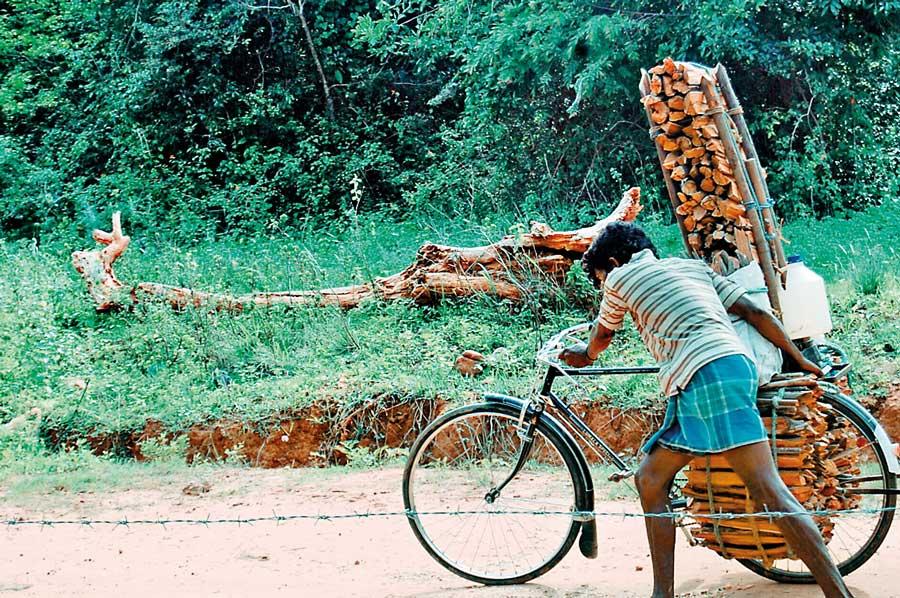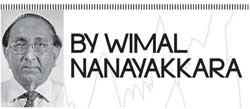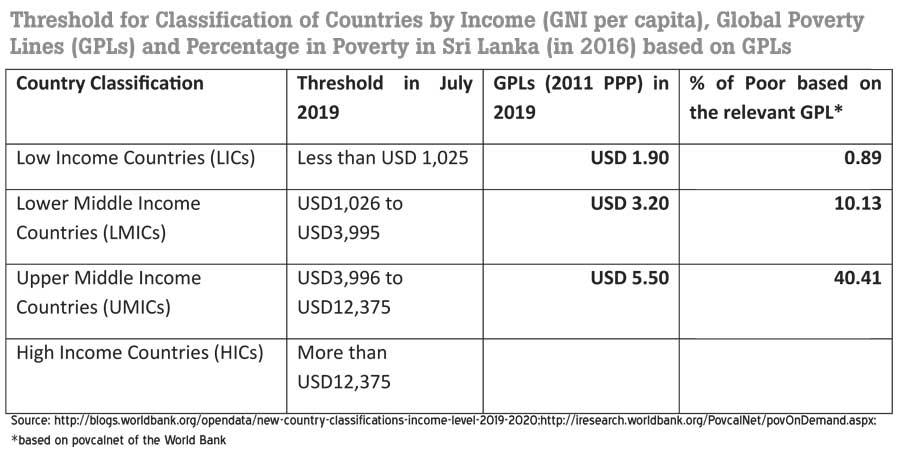07 Feb 2020 - {{hitsCtrl.values.hits}}

 Sri Lanka achieved the ‘upper-middle-income country’ (UMIC) status in July 2019, as the country’s gross national income (GNI) increased from US $ 3,840 per capita in 2018 to US $ 4,060 per capita in 2019. The World Bank’s (WB) new threshold for UMICs is US $ 3,996–US $ 12,375 GNI per capita.
Sri Lanka achieved the ‘upper-middle-income country’ (UMIC) status in July 2019, as the country’s gross national income (GNI) increased from US $ 3,840 per capita in 2018 to US $ 4,060 per capita in 2019. The World Bank’s (WB) new threshold for UMICs is US $ 3,996–US $ 12,375 GNI per capita.
Sri Lanka scraped by the line of demarcation to enter the new threshold for UMICs and is still at the lower end of the spectrum. As such, there is still a risk of slipping back to lower-middle-income country (LMIC) status again, if the economy does not progress at a level expected for a UMIC.
Based on the WB’s Global Poverty Line (GPL) for UMICs – US $ 5.50 a day per person (2011 PPP or using 2011 prices) – 40.4 percent Sri Lanka’s population are in poverty. But based on the National Poverty Line (NPL) currently used in Sri Lanka, only 4.1 percent were in poverty in 2016. However, as long as the country is in the UMIC status, poverty levels should be measured using the GPL US $ 5.50 a day per person (2011 PPP).
Even though all countries have their own poverty measures to estimate poverty at the national and regional levels, it would not be appropriate to use the current NPL to estimate poverty in Sri Lanka, due to the following reasons: (i) Sri Lanka has graduated to UMIC status, (ii) vast changes in the economy and the income distributions expected in the near future, owing to the rapid technological advancements of the Fourth Industrial Revolution (4IR), (iii) the current NPL is based on the market value of a basket of goods and services based on the 2002 Household Income and Expenditure Survey, (iv) most UMICs and high-income countries use ‘relative poverty’ instead of ‘absolute poverty’ measures used in Sri Lanka.
This article presents some important points statisticians, planners and policymakers should consider when developing methodologies and measurements to estimate poverty in Sri Lanka in the future.

Measuring poverty in SL under UMIC status
With the elevation of Sri Lanka to the UMIC status, it is not appropriate to use the poverty lines meant for LMICs for inter-country comparisons. The GPL of US $ 1.90 a day is the poverty line used to estimate extreme poverty and represents the typical condition of the world’s poorest countries.
This GPL is also used to estimate extreme poverty in other countries. Based on it (US $ 1.90 a day), only 0.89 percent of Sri Lanka’s population were in extreme poverty in 2016.
For international comparisons, Sri Lanka used US $ 3.20 a day measure (until the country was elevated to the UMIC status), under which 10.13 percent of the population were in poverty in 2016. With the elevation to UMIC status, Sri Lanka will have to use the GPL of US $ 5.50 a day.
In this context, Sri Lanka cannot continue to use the current NPL to measure poverty levels in the country. If the country is to maintain the UMIC status, it is necessary to revise the NPL. One of the main considerations would be whether to continue with the concept of absolute poverty or adopt the concept of relative poverty, like most other UMICs. Relative poverty is a condition where household income is a certain percentage below the Median Household Income. For example, the threshold for relative poverty could be set at 40 percent, 50 percent or 60 percent of the Median Household Incomes. Relative poverty is useful for showing the percentage of the population who have been left behind.
Based on the HIES-2016 conducted by the Census and Statistics Department, 7.8 percent of the population is below 40 percent of the Median Household Income, 12.3 percent of the population is below 50 percent of the Median Household Income and 18.2 percent are below 60 percent of the Median
Household Income.
A decision needs to be taken on which threshold Sri Lanka should adopt and then develop a suitable methodology to measure poverty in the future.
Way forward
It is not possible to take an arbitrary decision on the best method of measuring poverty in Sri Lanka in its new reality as a UMIC. For international comparisons, it would be necessary to use the GPL US $ 5.50 a day. For poverty estimates at national level and regional level, it would be necessary to develop a suitable methodology/criterion, as an UMIC country.
The Census and Statistics Department may have to develop an acceptable methodology to estimate poverty in Sri Lanka in the future. To achieve this, it is important to initiate a dialogue with planners, policymakers and other stakeholders.
(Wimal Nanayakkara is a Senior Visiting Fellow at the Institute of Policy Studies of Sri Lanka (IPS). To talk to the author, email [email protected]. To view this article online and to share your comments, visit the IPS Blog ‘Talking Economics’ - http://www.ips.lk/talkingeconomics/)
26 Dec 2024 23 minute ago
26 Dec 2024 29 minute ago
26 Dec 2024 1 hours ago
26 Dec 2024 2 hours ago
26 Dec 2024 4 hours ago